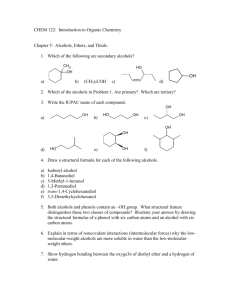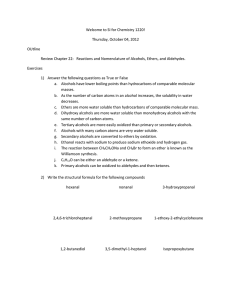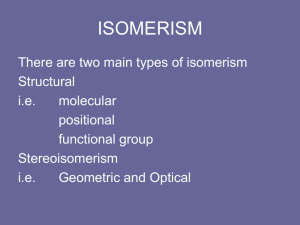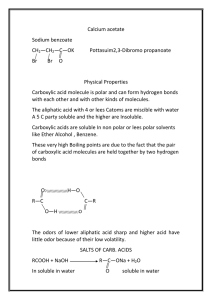ORGANIC CHEMISTRY ALCOHOLS A Study Guide for alcohols, ethers, aldehydes, ketones,
advertisement
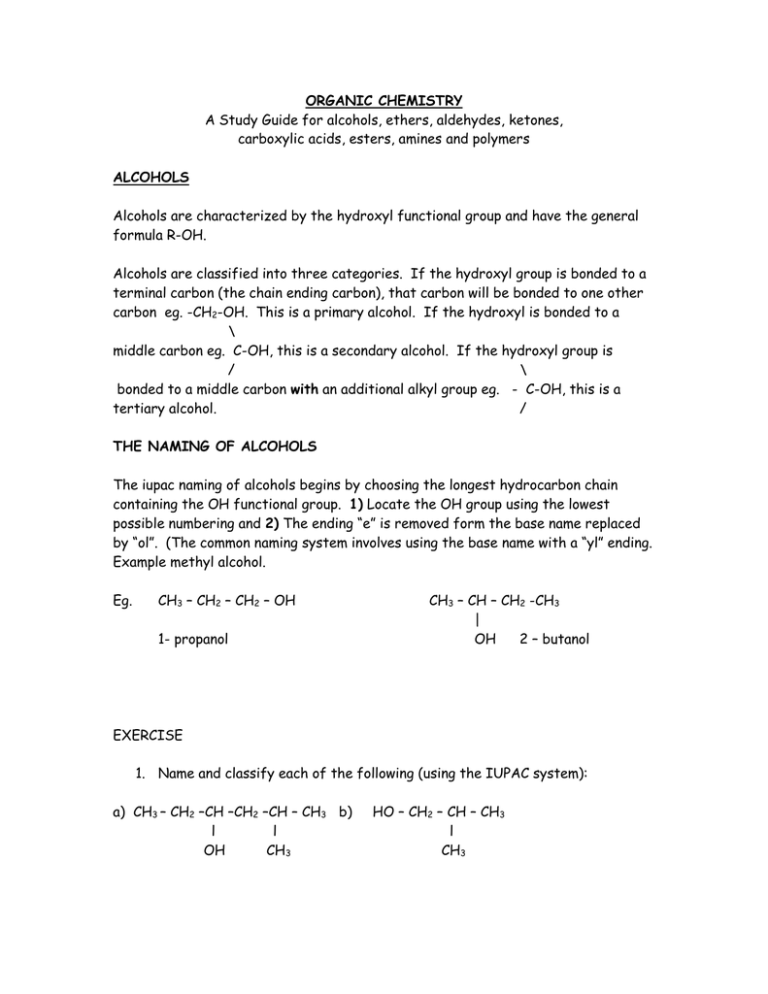
ORGANIC CHEMISTRY A Study Guide for alcohols, ethers, aldehydes, ketones, carboxylic acids, esters, amines and polymers ALCOHOLS Alcohols are characterized by the hydroxyl functional group and have the general formula R-OH. Alcohols are classified into three categories. If the hydroxyl group is bonded to a terminal carbon (the chain ending carbon), that carbon will be bonded to one other carbon eg. -CH2-OH. This is a primary alcohol. If the hydroxyl is bonded to a \ middle carbon eg. C-OH, this is a secondary alcohol. If the hydroxyl group is / \ bonded to a middle carbon with an additional alkyl group eg. - C-OH, this is a tertiary alcohol. / THE NAMING OF ALCOHOLS The iupac naming of alcohols begins by choosing the longest hydrocarbon chain containing the OH functional group. 1) Locate the OH group using the lowest possible numbering and 2) The ending “e” is removed form the base name replaced by “ol”. (The common naming system involves using the base name with a “yl” ending. Example methyl alcohol. Eg. CH3 – CH2 – CH2 – OH 1- propanol CH3 – CH – CH2 -CH3 | OH 2 – butanol EXERCISE 1. Name and classify each of the following (using the IUPAC system): a) CH3 – CH2 –CH –CH2 –CH – CH3 b) l l OH CH3 HO – CH2 – CH – CH3 l CH3 OH l c) H3C – C – CH3 | CH3 2. Draw the structural formula for: a) 2 – pentanol c) 2 – methyl – 2- propanol b) 4,4 – dimethyl -1- hexanol PROPERTIES OF ALCOHOLS 1. Alcohols, because of the more electronegative hydroxyl group are soluble in water for up to 3 carbons. Solubility decreases rapidly after propanol as each carbon is added. 2. Alcohols are generally liquids up to 12 carbons. The melting points of alcohols compared to alkanes with similar mass are much higher due to the presence of hydrogen bonds. (methanol boils at 65oC, ethane boils at –89o C). 3. Alcohols are flammable and may be used as fuels. Methanol raises the octane of gasoline possessing an octane rating of 110. REACTIONS OF ALCOHOLS 1. Alcohols are prepared by the addition of water (in acid) to an alkene. Alkenes readily undergo addition reactions. H2C=CH2 + H-OH H+ CH3 – CH2 – OH A strong dehydrating agent, like H2SO4, can reverse the above reaction. 2. Alcohols can burn in the presence of oxygen to form CO2 and H2O. 3. Primary alcohols can undergo oxidation and the result is an aldhyde and eventually a carboxylic acid. H3C-OH KMnO4 H2C=O KMnO4 HCOOH 4. Secondary alcohols can undergo oxidation and the result is a ketone. OH | CH3 – CH2 –CH – CH3 KMnO4 O || CH3 – CH2 –C –CH3 5) Tertiary alcohols resist oxidation. Questions 1. Write the reaction of how you would prepare 2-pentanol. Could you produce this in 100% yield? 2. What functional group would be the result of the addition of KMnO4 to: a) 2-butanol b) 3-methyl-3-hexanol c) ethanol 3. Write the balanced chemical equation for the combustion of 1-propanol. 4. If methanol was oxidized to methanal (aldehyde) and KMnO4 was reduced to MnO2; give the balanced redox reaction if it took place in an acidic solution.

